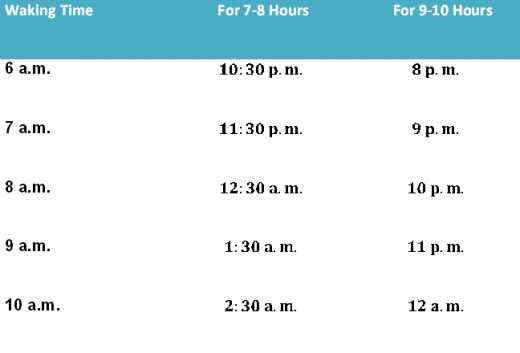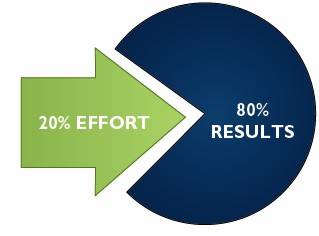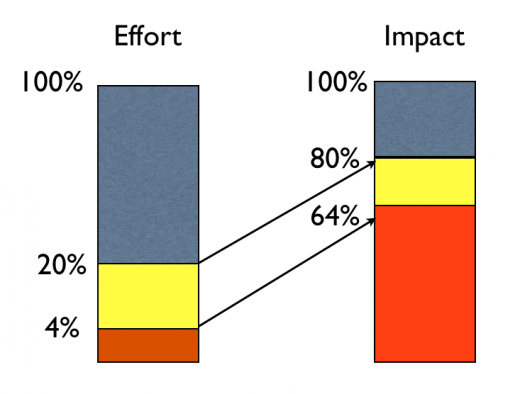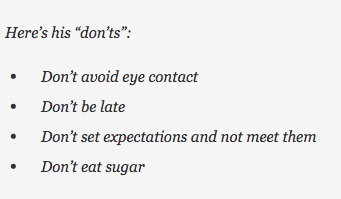
This post originally appeared on The Growth List
Let’s face it.
We all want more time in our lives.
It could be an evening to spend more time with our family and friends, a 30-hour day to grow our business, or simply time to close our eyes and relax.
If you would like to make more effective use of your time, maintain your energy levels throughout the day, and achieve your goals faster — read on.
I’ve already written a few pieces on and avoiding the 9 to 5, but this is going to be a complete guide to productivity.
In this complete guide to productivity, we’ll discuss:
- Scheduling
- Goal Priortization
- Getting Help
- Productivity Treasure Chest
Scheduling
Scheduling your day, week, and even month ahead of time is going to be crucial for maximizing your time and getting things done.
As Peter Thiel says, “a bad plan is always better than no plan at all.”
So how do we schedule our time in order to be more effective?
The 90-Minute Rule
You may have heard about the 90-minute rule applying to your sleeping cycle. The rule is that we want to be sleeping in 90-minute cycles, and should be timing our sleep durations to wake up at the right times.
The 90-minute rule also applies to your working cycle.
We should be working in 90-minute segments, where we’re giving a 100 percent of our focus on a single task or a series of similar tasks for a maximum length of 90-minutes.
Here’s what my calendar looks like as an example:
Personally, I usually give myself a deadline buffer of an hour and 20 minutes because I know things will always take longer than expected.
Ideally, you should batch tasks that require similar physical or brain activity.
For example, I do all of my creative work such as writing blog posts, or copywriting in the morning. If I have to schedule calls or interviews that involve getting on the phone, I try to batch all of those together as well. You could even batch and schedule social media browsing into your calendar, and use that time to unwind — guilt free!
After the “90-minute” interval, take a 30-minute break to do whatever you can to energize yourself, whether it’s stretching, going for a walk, getting on a call with a friend, eating. Discover the activities that energizes you and perform them during your rest periods.
Recommended Business Apps
Remember not to give yourself more time than you need, the less time the better. As “Parkinson’s Law” suggests, if we give ourselves three hours to do something, that’s exactly how long we will take — no matter what the task.
However, if we give ourselves an hour to do the same tasks — more often than not, we’ll find a way to get it done.
In other words, try to trick your own brain to be more productive!
Pareto Your Life
The Pareto Principle was introduced by an Italian businessman, Vilfredo Pareto, who noticed that 80 percent of land was held by 20 percent of individuals.
The theory was expanded into almost every aspect of our lives — business, happiness, wealth, and yes time management.
Think about how you go about your day, week, or month.
What’s the 20 percent of your efforts that will result in 80 percent of your achievements and results?
Do you have large clients that are bringing in 80 percent of your revenue? Or maybe you could focus the 20 percent of your time sending that special someone a surprise gift/note that will provide the 80 percent of your happiness.
Now let’s go a step further.
Theoretically, we can apply Pareto’s law twice. Let’s apply Pareto’s law to that 20 percent of your time that garners 80 percent of your impact. Without getting into the mathematics, the goal is to find 4 percent of your time spent garnering 64 percent of your impact (Boring explanation: 20/80 ing the original 20 percent of your effort resulting in your 80 percent impact).
The point is to take a step back at to analyze your end goals and achievements, then find how and what will get you there faster.
This brings us to our next point…
Prioritize Your Goals
If you’re like most people, you probably have a list of tasks and goals to accomplish on a daily, weekly, and monthly basis.
How you priortize these activities will be the ultimate determinant of whether you are effective in getting what you want done.
The Morning Routine
1. Be selfish in the morning: It’s okay to be 100 percent selfish in the morning.
In fact, it’s a necessity if you want to be productive. What most of us do is wake up in the morning and immediately check our emails. This means we are starting our day under other people’s agenda — not ours.
The most successful people leverage their mornings to invest in themselves, whether it’s meditating, exercising, or simply sitting down and eating a healthy breakfast.
This is often the only period of time during our day to reflect, energize, and prepare ourselves for the day ahead of us. Treasure your mornings.
2. The cold shower: A cold shower beats a cup of coffee any day.
Here’s how to do it:
The next time you take a shower in the morning or night time, depending on your style, go through your normal routine in your normal shower temperature.
Once you’ve finished, turn the hot water off and go completely cold. Hold for 10–15 seconds, then go completely hot. Hold for another 10–15 seconds, then go completely cold for 10–15 seconds.
What this does for our bodies is it opens up our blood flow and gets our immune system going, which not only wakes us up, but is a healthy routine for our bodies.
Now if you want a shortcut, you can go straight to the cold for 10–15 seconds, which should do a hell of a job waking you up.
3. Get Creative: Studies have shown that we’re the most creative in the morning because our prefrontal cortex is the most active during and after sleep.
This means that any creative work, whether it’s writing, brainstorming, and ideating, should be scheduled during the initial hours in the day.
As mentioned above, I normally do my writing or strategic planning in the morning, and it’s very effective.
If you want to know how to be more creative, check out this post.
Make Your Top 3 List At Night
Now it’s time for your night routine.
Before you head to bed or before you leave the office, make a list of the Top 3 things you must get done tomorrow that will result in 80 percent of your results.
Make sure it’s no more than three, and if you can go further and identify just one task that will reach your 80 percent, then that’s what you should put down.
Personal note: what tends to work for me is writing my top 3 list on a Post-It Note and sticking it on my computer so I can visually see it the entire time.
Create a Not To-Do List
It’s just as important to know what you shouldn’t do because it will help you focus on what you should do.
Jack Dorsey, founder of Twitter & Square, is a big advocate of creating a Not To-Do List.
Credit to Lifehacker
Now reflect on the bad habits that are distracting you from focusing and getting your best work done.
- checking email too often
- going on Facebook and Instagram
- having many tabs open
- working too long
You can also combine this with your To-Do List on the same Post-It Note, so you’ll be able to see it the entire time. Often, being able to see your Not To-Do List will be more effective.
Getting Help
As entrepreneurs or simply Type-A individuals, we have the tendency to want to do everything ourselves. It’s hard to imagine others taking over and delivering the same type of quality results that we have.
Truth is, there’s only so much we can do ourselves in 24 hours. Not only do we need to think about the opportunity cost of doing admin tasks, we need to think about growth.
How many successful one-man businesses have you heard of?
There will come a certain inflection point in our careers, where there will be a direct ROI on the time we spend working. We always have to look at the opportunity cost of what we’re doing.
For example:
Let’s say you’re able to make $500 in 3 hours by taking coaching calls, getting on the phone with a potential client, or selling your products online.
However, you’re currently spending three hours per day cleaning your house, doing laundry, cooking, etc. Then it would make sense to hire a maid for $100–150 for those 3 hours to do those tasks for you, while you can spend your time growing your business.
Even if there’s no direct ROI, you should be looking to outsource the tasks that are not focused on growth or what you’re not good at, so you can free up time to focus on what matters.
3 Lists of Freedom
Here’s a powerful exercise created by Chris Ducker, that is going to change the way you think about your time.
First, grab a pen and a notebook.
Now create 3 columns in your notebook with the categories:
- What you HATE doing
- What you CAN’T do
- What you SHOULDN’T be doing
Take some time with this, and fill these out throughout the week as you keep track of the unproductive tasks you are doing.
Here’s an example of what this looks like:
Virtual Assistant
Now that you’ve designed your 3 Lists to Freedom, it’s time to search for your first virtual assistant.
Here are some places you can start looking:
- oDesk
- Elance
- Freelancer
- Virtual Staff Finder ($500 finders fee)
- Zirtual
- TaskBullet
You can find a good virtual assistant for around $10/hour. Now it’s important to note that you do get what you pay for, and investing that extra $5–10/hour (if you have the budget) will be worthwhile in the long-run.
Companies such as Zirtual and TaskBullet have starter packages where you can pay $200–$400 a month to get started. If you’ve never hired a virtual assistant before, starting with a smaller package like this would be a good idea.
When looking at which tasks to outsource initially, Chris advises starting with tasks you hate doing. This will help you appreciate the value of your assistant, as you’ll be able to see them as an opportunity to do work you love rather than work you hate.
Reminders
A virtual assistant isn’t the only person you can get help from to stay productive.
We can use our smartphones to set up reminders to keep us on track.
Here’s how it works:
Download a reminder app such as Any.do, Dueapp, or you could use Google Calendar and download the app on your phone.
Set up an event that occurs every 3 hours with the title of the event being:
Is this what you should be working on?
Feel free to change around the title if you can find one that will better motivate you.
At the end of the day, we’re all humans and getting distracted is inevitable in a smartphone crazed society. Creating a system of reminders that will keep us grounded can do wonders if we’re constantly being distracted.
Treasure Chest
Here is a treasure chest of resources I suggest checking out to increase your productivity!
Recommended Apps:
- Google Calendar: Calendar app by Google
- RescueTime: Time tracker of your online activities
- Evernote: Digital workspace for your life
- Wunderlist: Multiple category checklists
- LastPass: Remember all your passwords
- Pocket: Save articles and read them later
- Buffer: Schedule your social media posts ahead of time
- Latergram.me: Schedule your instagram posts ahead of time
- Boomerang: Schedule your emails ahead of time
- Pavlok: Habit changing wearable technology
- Asana & Trello & Basecamp: Project management systems
- Mailbox: Best way to manage your emails
- Dropbox: Store and collaborate by sharing files
- IFTTT: Automate tasks on your phone and computer
Recommended Books:
- Getting Things Done
- Do The Work
- Essentialism
- REWORK
- The Seven Habits of Highly Effective People
- The Power of Habit
- Getting Results the Agile Way
- Lean Startup
- The Power of Less
- The ONE Thing
- Virtual Freedom
- The 4 Hour Workweek
Recommended Blogs:
While this post is just the tip of the productivity iceberg, it’s a great place to start changing your daily routines to make a better, more productive you.
Read Next: 5 ways to tackle the complexity of your next big project
Get the TNW newsletter
Get the most important tech news in your inbox each week.










